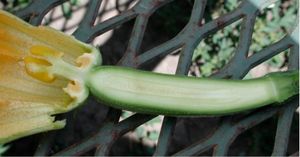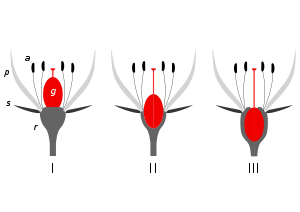- Ovary (plants)
-
In the flowering plants, an ovary is a part of the female reproductive organ of the flower or gynoecium. Specifically, it is the part of the pistil which holds the ovule(s) and is located above or below or at the point of connection with the base of the petals and sepals. The pistil may be made up of one carpel or of several fused carpels, and therefore the ovary can contain part of one carpel or parts of several fused carpels. In this picture of a zucchini the petals and sepals are above the ovary and such a flower is said to have an inferior ovary; also referred to as epigynous. Above the ovary is the style and the stigma, which is where the pollen lands and germinates to grow down through the style to the ovary, and, for each individual pollen grain, to grow into one individual ovule. Some wind pollinated flowers have much reduced and modified ovaries.
Contents
Fruits
A fruit is the ripened ovary or ovaries—together with seeds—from one or more flowers. The fruits of a plant are responsible for dispersing the seeds that contain the embryo and protecting the seeds as well. In many species, the fruit incorporates some surrounding tissues, or is dispersed with some non-fruit tissues.
Parts of the ovary
- Valves
- Obturator
Classification based on position
The terminology of the positions of ovaries is determined by the insertion point, where the other floral parts (perianth and androecium) come together and attach to the surface of the ovary. [1] If the ovary is situated above the insertion point, it is superior; if below, inferior.
Superior ovary
A superior ovary is an ovary attached to the receptacle above the attachment of other floral parts. A superior ovary is found in types of fleshy fruits such as true berries, drupes, etc. A flower with this arrangement is described as hypogynous. An example is Hypericum calycinum.
An ovary becomes superior during anthesis (flower formation) when the upper portion of the ovary grows more than the lower part[citation needed].
Inferior ovary
An inferior ovary lies below the attachment of other floral parts. A pome is a type of fleshy fruit that is often cited as an example, but close inspection of some pomes (such as Pyracantha) will show that it is really a half-inferior ovary. Flowers with inferior ovaries are termed epigynous. Some examples of flowers with an inferior ovary are orchids (inferior capsule), Fuchsia (inferior berry), Asteraceae (inferior achene-like fruit, called a cypsela).
Half-inferior ovary
A half-inferior ovary (also known as “half-superior”, “subinferior,” or “partially inferior,”) is embedded or surrounded by the receptacle.[2] This occurs in flowers of the Lythraceae family, which includes the Crape Myrtles. Such flowers are termed perigynous or half-epigynous. In some classifications, half-inferior ovaries are not recognized and are instead grouped with either the superior or inferior ovaries.
More specifically, a half-inferior ovary has nearly equal portions of ovary above and below the insertion point. Other varying degrees of inferiority can be described by other fractions. For instance, a "one-fifth inferior ovary" has approximately one fifth of its length under the insertion point. Likewise, only one quarter portion of a "three-quarters inferior ovary" is above the insertion.
See also
References
- ^ Soltis et al.; Fishbein, Mark; Kuzoff, Robert K. (2003). "Evolution of Epigyny". International Journal of Plant Sciences 164 (S5): S251–S264. doi:10.1086/376876.
- ^ Soltis & Hufford; Hufford, Larry (2002). "Ovary Position Diversity in Saxifragaceae". International Journal of Plant Sciences 163 (2): 277–293. doi:10.1086/324528.
Categories:- Organs
- Plant morphology
Wikimedia Foundation. 2010.


